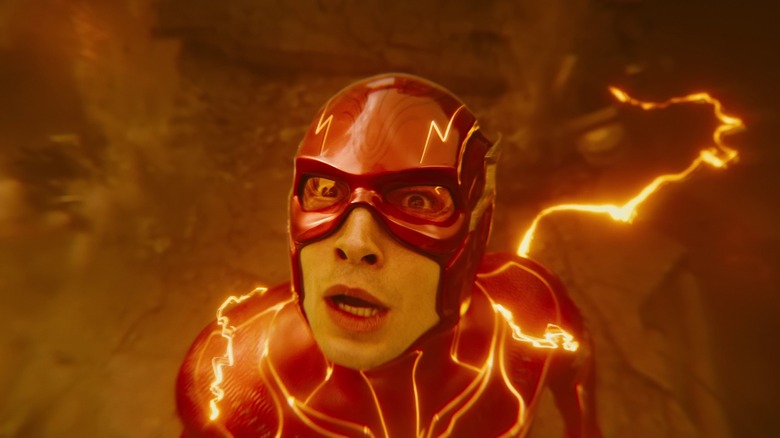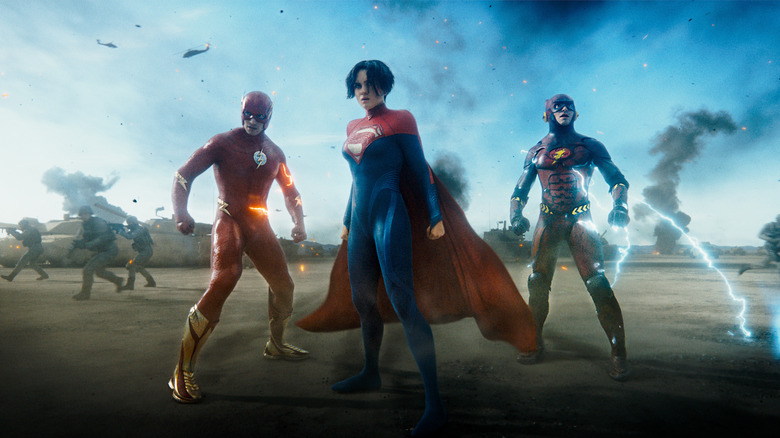The Flash Director Says The Weird Visual Effects Choices Were Intentional
This post contains major spoilers for the new DC film "The Flash."
In the new superhero flick "The Flash," one of the final films in the decade-long DC Extended Universe, the title hero (Ezra Miller) finds he can run so fast, he can pass into another dimension. In said dimension, which he calls the Speed Force, the Flash is surrounded by a protective bubble at the bottom of what appears to be an operating theater or miniature gladiatorial arena. In comic book parlance, the arena is called the Chrono Bowl. Surrounding the Flash in the Chrono Bowl is a swirling CGI morass of images that represent multiple tiny moments of the past. He is able to fast-forward and rewind through these images at will, and then select a window of time where he might want to exit. The Flash then exits his bubble and appears in the past, effectively traveling through time.
The morass of images inside the Chrono Bowl could have been live-action actors, but are instead CGI models of the actors. They whiz by like repeated images in a zoetrope. The look is distinctly artificial. It seems that director Andy Muschietti wasn't aiming for realism in these scenes, but a heightened, plasticine aesthetic.
The same might be said of certain late-in-the-film cameo appearances. Several actors, some of them dead, are recreated in CGI during a sequence wherein various parallel-universe superheroes each peer through an aperture in the space-time continuum. The actors do not look realistic, bearing the same plastic look that many non-motion-capture CGI characters have bore for decades.
Guess what: all of that was intentional. In an interview with Gizmodo's io9, Muschietti explained that the DCEU movies were indeed meant to look artificial. It was all on purpose.
We used real babies
io9 asked Andy Muschietti and the film's producer, his sister, Barbara Muschietti, about why the SFX in the film looked odd when compared to the ultra-slick, often-realistic effects seen in most major superhero blockbusters. The interviewer cited an early scene in the movie where the Flash saves a dozen babies who have been blown through the window of a maternity ward, dozens of floors up from the street. Because the Flash can move so quickly, he's able to bound up the pieces of falling rubble, grab the babies, and line them up on a gurney, which he then guides to the ground safely. But why did the babies look so odd? Barbara jokes that they actually used real babies. Andy then clarified:
"The idea, of course, is ... we are in the perspective of the Flash. [...] Everything is distorted in terms of lights and textures. We enter this 'waterworld' which is basically being in Barry's POV. It was part of the design so if it looks a little weird to you that was intended."
Indeed, all of the odd-looking CGI moments, including the Superman cameos, all took place while the Flash was in the midst of using his speed powers to slow down the world. If the Flash moves faster than the speed of light, then it makes sense that he would perceive light and gravity differently. There are no scenes of technobabble to explain this in the movie, but it's also a broad, expensive superhero fantasy, so a little bit of artificiality is appropriate.
The popular, realism-skewing "Batman Begins" came out 18 years ago, after all. Also, "The Flash" is part of the same universe as "Aquaman." Perhaps abiding by the rules of gravity and realism isn't so important anymore.

